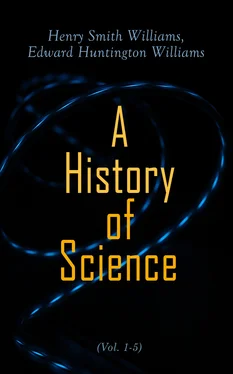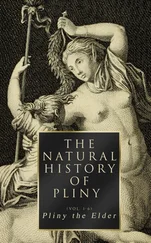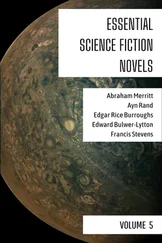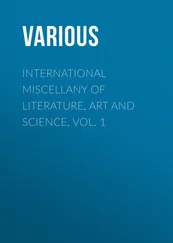But it remains to notice the most interesting feature of this document in which the calculation of the sand-grains is contained. "It was known to me," says Archimedes, "that most astronomers understand by the expression 'world' (universe) a ball of which the centre is the middle point of the earth, and of which the radius is a straight line between the centre of the earth and the sun." Archimedes himself appears to accept this opinion of the majority—it at least serves as well as the contrary hypothesis for the purpose of his calculation—but he goes on to say: "Aristarchus of Samos, in his writing against the astronomers, seeks to establish the fact that the world is really very different from this. He holds the opinion that the fixed stars and the sun are immovable and that the earth revolves in a circular line about the sun, the sun being at the centre of this circle." This remarkable bit of testimony establishes beyond question the position of Aristarchus of Samos as the Copernicus of antiquity. We must make further inquiry as to the teachings of the man who had gained such a remarkable insight into the true system of the heavens.
ARISTARCHUS OF SAMOS, THE COPERNICUS OF ANTIQUITY
It appears that Aristarchus was a contemporary of Archimedes, but the exact dates of his life are not known. He was actively engaged in making astronomical observations in Samos somewhat before the middle of the third century B.C.; in other words, just at the time when the activities of the Alexandrian school were at their height. Hipparchus, at a later day, was enabled to compare his own observations with those made by Aristarchus, and, as we have just seen, his work was well known to so distant a contemporary as Archimedes. Yet the facts of his life are almost a blank for us, and of his writings only a single one has been preserved. That one, however, is a most important and interesting paper on the measurements of the sun and the moon. Unfortunately, this paper gives us no direct clew as to the opinions of Aristarchus concerning the relative positions of the earth and sun. But the testimony of Archimedes as to this is unequivocal, and this testimony is supported by other rumors in themselves less authoritative.
In contemplating this astronomer of Samos, then, we are in the presence of a man who had solved in its essentials the problem of the mechanism of the solar system. It appears from the words of Archimedes that Aristarchus; had propounded his theory in explicit writings. Unquestionably, then, he held to it as a positive doctrine, not as a mere vague guess. We shall show, in a moment, on what grounds he based his opinion. Had his teaching found vogue, the story of science would be very different from what it is. We should then have no tale to tell of a Copernicus coming upon the scene fully seventeen hundred years later with the revolutionary doctrine that our world is not the centre of the universe. We should not have to tell of the persecution of a Bruno or of a Galileo for teaching this doctrine in the seventeenth century of an era which did not begin till two hundred years after the death of Aristarchus. But, as we know, the teaching of the astronomer of Samos did not win its way. The old conservative geocentric doctrine, seemingly so much more in accordance with the every-day observations of mankind, supported by the majority of astronomers with the Peripatetic philosophers at their head, held its place. It found fresh supporters presently among the later Alexandrians, and so fully eclipsed the heliocentric view that we should scarcely know that view had even found an advocate were it not for here and there such a chance record as the phrases we have just quoted from Archimedes. Yet, as we now see, the heliocentric doctrine, which we know to be true, had been thought out and advocated as the correct theory of celestial mechanics by at least one worker of the third century B.C. Such an idea, we may be sure, did not spring into the mind of its originator except as the culmination of a long series of observations and inferences. The precise character of the evolution we perhaps cannot trace, but its broader outlines are open to our observation, and we may not leave so important a topic without at least briefly noting them.
Fully to understand the theory of Aristarchus, we must go back a century or two and recall that as long ago as the time of that other great native of Samos, Pythagoras, the conception had been reached that the earth is in motion. We saw, in dealing with Pythagoras, that we could not be sure as to precisely what he himself taught, but there is no question that the idea of the world's motion became from an early day a so-called Pythagorean doctrine. While all the other philosophers, so far as we know, still believed that the world was flat, the Pythagoreans out in Italy taught that the world is a sphere and that the apparent motions of the heavenly bodies are really due to the actual motion of the earth itself. They did not, however, vault to the conclusion that this true motion of the earth takes place in the form of a circuit about the sun. Instead of that, they conceived the central body of the universe to be a great fire, invisible from the earth, because the inhabited side of the terrestrial ball was turned away from it. The sun, it was held, is but a great mirror, which reflects the light from the central fire. Sun and earth alike revolve about this great fire, each in its own orbit. Between the earth and the central fire there was, curiously enough, supposed to be an invisible earthlike body which was given the name of Anticthon, or counter-earth. This body, itself revolving about the central fire, was supposed to shut off the central light now and again from the sun or from the moon, and thus to account for certain eclipses for which the shadow of the earth did not seem responsible. It was, perhaps, largely to account for such eclipses that the counter-earth was invented. But it is supposed that there was another reason. The Pythagoreans held that there is a peculiar sacredness in the number ten. Just as the Babylonians of the early day and the Hegelian philosophers of a more recent epoch saw a sacred connection between the number seven and the number of planetary bodies, so the Pythagoreans thought that the universe must be arranged in accordance with the number ten. Their count of the heavenly bodies, including the sphere of the fixed stars, seemed to show nine, and the counter-earth supplied the missing body.
The precise genesis and development of this idea cannot now be followed, but that it was prevalent about the fifth century B.C. as a Pythagorean doctrine cannot be questioned. Anaxagoras also is said to have taken account of the hypothetical counter-earth in his explanation of eclipses; though, as we have seen, he probably did not accept that part of the doctrine which held the earth to be a sphere. The names of Philolaus and Heraclides have been linked with certain of these Pythagorean doctrines. Eudoxus, too, who, like the others, lived in Asia Minor in the fourth century B.C., was held to have made special studies of the heavenly spheres and perhaps to have taught that the earth moves. So, too, Nicetas must be named among those whom rumor credited with having taught that the world is in motion. In a word, the evidence, so far as we can garner it from the remaining fragments, tends to show that all along, from the time of the early Pythagoreans, there had been an undercurrent of opinion in the philosophical world which questioned the fixity of the earth; and it would seem that the school of thinkers who tended to accept the revolutionary view centred in Asia Minor, not far from the early home of the founder of the Pythagorean doctrines. It was not strange, then, that the man who was finally to carry these new opinions to their logical conclusion should hail from Samos.
But what was the support which observation could give to this new, strange conception that the heavenly bodies do not in reality move as they seem to move, but that their apparent motion is due to the actual revolution of the earth? It is extremely difficult for any one nowadays to put himself in a mental position to answer this question. We are so accustomed to conceive the solar system as we know it to be, that we are wont to forget how very different it is from what it seems. Yet one needs but to glance up at the sky, and then to glance about one at the solid earth, to grant, on a moment's reflection, that the geocentric idea is of all others the most natural; and that to conceive the sun as the actual Centre of the solar system is an idea which must look for support to some other evidence than that which ordinary observation can give. Such was the view of most of the ancient philosophers, and such continued to be the opinion of the majority of mankind long after the time of Copernicus. We must not forget that even so great an observing astronomer as Tycho Brahe, so late as the seventeenth century, declined to accept the heliocentric theory, though admitting that all the planets except the earth revolve about the sun. We shall see that before the Alexandrian school lost its influence a geocentric scheme had been evolved which fully explained all the apparent motions of the heavenly bodies. All this, then, makes us but wonder the more that the genius of an Aristarchus could give precedence to scientific induction as against the seemingly clear evidence of the senses.
Читать дальше












